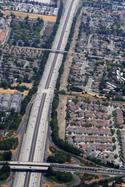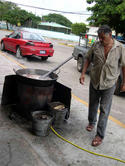Urban Issues
In the discussions of the stimulus and infrastructure problem, little attention has yet been paid to addressing brain drain. Yet for many regions – particularly in the old industrial heartland – no issue could be more critical.
Perhaps the most important investment in regional human capital occurs at local schools. Enterprise looks to the secondary and post-secondary institutions within the area for labor. In this regard, it makes sense to fund better learning with local and state taxes as long as that talent remains within that geography. read more »
Among potential titles for this article about the Hyde Park neighborhood of St. Louis, I played with The Archaeology of Stasis. My husband suggested It’s Not Happening Here. But neither seemed right. Both were too depressing to describe a place where people are working hard for change. I wanted a title that suggested a lot of hard work, but hope nonetheless. read more »
You would think an economic development official in Michigan these days would be contemplating either early retirement or seppuku. Yet the feisty Ron Kitchens, who runs Southwest Michigan First out of Kalamazoo, sounds almost giddy with the future prospects for his region.
How can that be? Where most of America sees a dysfunctional state tied down by a dismal industry, Kitchens points to the growth of jobs in his region in a host of fields, from business services to engineering and medical manufacturing. Indeed, as most Michigan communities have lost jobs this decade, the Kalamazoo region, with roughly 300,000 residents, has posted modest but consistent gains. read more »
The current recession provides a new opportunity for Pittsburgh's elite to feel good about itself. With other boom economies from Phoenix to Miami on the skids – and other old Rust Belt cities like Detroit, Cleveland and Buffalo even more down on their luck – the slow-growth achievements of the Pittsburgh region may seem rather impressive.
Yet at the same time, the downturn also poses longer-term challenges for which the local leadership is likely to have no answers. read more »
By Richard Reep
Noted architect Daniel Liebeskind, teaching at Yale in the early 1990s, proclaimed “Public space is dead”. A provocative notion at the time, he was simply observing American cultural phenomena, and our evolution away from Main Street into the mall, away from the downtown church to the suburban megachurch, and away from common space into private space. While all this is true, it misses a countercyclical element in our cities, and in the Orlando area, public space is very much alive and assuming a new role in the neighborhoods. read more »
For centuries, the West sent missionaries around the world to spread various gospels. It is no different now, though the clerics tend to hold degrees from planning schools rather than those overtly specializing in theology.
This could also create tragic results as ideologies created in one context are imported into a totally foreign one. read more »
Part Two. Yesterday, in Part One, Critser discussed scientific advances in understanding air pollution. Today, he addresses the social implications.
The new science of air pollution, with its emphasis on dose-response mechanisms, may remake the traditional advocacy realm of social and environmental justice. In the past, that world has been focused on class, race and ethnicity, classic markers of inequality and vulnerability. Today, the focus is more “exposure driven.” “Dosage… may be something people who have ignored environmental justice can get their heads around,” one researcher at last month’s Environmental Epidemiology conference in Pasadena noted. “It may get people’s attention on something that affects us all.” read more »
Part One of A Two-Part Series
Not long ago, Michael Woo, a former Los Angeles city councilman and current member of the Los Angeles City Planning Commission, took up a case pending approval by that body: a mixed housing-retail development near the intersection of Cahuenga Boulevard and Riverside Drive. Like many of the remaining buildable sites in the city, the property is right next to a roaring motorway; the windows of some apartments would look right out onto the 134 Freeway. To Angelinos, who have grown up in a car culture, it was hardly a remarkable proposal. But Woo, perhaps one of the brainier members of the city’s political elite—after losing a mayoral race to Richard Riordan in the early 1990s he became a professor of public policy at University of Southern California—had a problem with it, and he couldn’t quite let it go. read more »
Last month I visited a small town in southern Mexico. It is a quiet and modestly prosperous place. Outside some of the homes are older Suburbans, Jeeps and Explorers; the license plates show that their owners have recently returned from the US, driven out by the collapsing economy and heightened nativist anxieties. Almost every family, it seems, has some member who has spent time up north; only a very few of them are still hanging on through the recession. read more »
In all the many (how many) years I worked as an engineer in and around the auto industry, I got to compare conditions in Europe, Japan and America. Yet in many ways the American situation was perhaps the most tragic – the most potential, most eagerly squandered. It’s not Americans who are flawed, but the business model imposed from the top.
For example, I do not believe American engineers are inferior to those working elsewhere. It’s just the way their inputs are handled. Toyota and Honda have long-term viable plans that forecast many years down the road. This gives engineers a clear direction. read more »
|





















